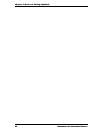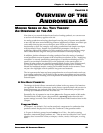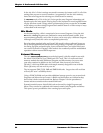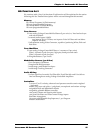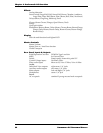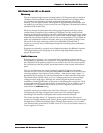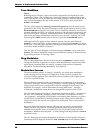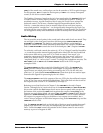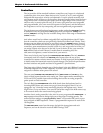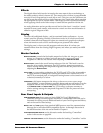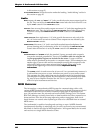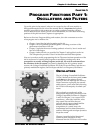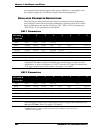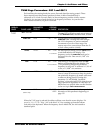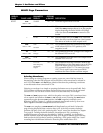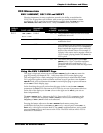
Chapter 4: Andromeda A6 Overview
100 ANDROMEDA A6 REFERENCE MANUAL
Controllers
The A6 provides all the standard hardware controllers you’d expect in a keyboard
synthesizer plus a few more. Most obvious is its 5-octave (C-to-C) semi-weighted
keyboard that responds to velocity and aftertouch. It can be played normally with
one Program across all keys, or can be split so that one Program plays from the lower
range of keys and a second Program plays from the upper range. In fact, three-way
and four-way (or more) splits are easy. In all cases, split points are user-assignable
and programmable. Also, two or more Programs can be layered, and the balance of
the Programs as well as any transposing are user-assignable and programmable.
The A6 features several keyboard performance modes under the
KBD MODE heading.
In addition to the A6’s polyphonic (
POLY) play mode, monophonic (MONO) and
unison (
UNISON X) voicings are also available along with a wide range of Portamento
(
PORTA) modes.
And where would we be without assignable Pitch and Modulation wheels? Notice
that the controller wheels are not specifically labeled Pitch Bend and Vibrato. That’s
because you can define each wheel as you like it using the
ASSIGN buttons. Some of
us like the Mod wheel to be the one on the right, because in the days of hard-wiring
controllers, most manufacturers just did it that way, and we got used to it. But you
can assign Vibrato to be the one on the left, if you so desire. In fact, you can make
both wheels Pitch or both Vibrato. Or make them do something else, like
add/remove brightness, control volume level, you name it.
There are also back panel inputs for
FOOTSWITCHES AND PEDALS. The A6’s PEDAL/CV
(commonly used for volume) and SUSTAIN pedal inputs allow the use of foot
controllers for master volume control and sustain. A third input jack labeled
SWITCH
is ideally suited for footswitch control of patch changes. The electrical specifications
for these switches and pedals are listed in Appendix C: Specifications.
That long strip of fabric along the top of the keyboard is the A6’s Ribbon Controller.
Normally assigned to the VCOs’ frequency to create a pitch bend device, it can be
assigned to countless other parts of the sound.
The rear-panel
CONTROL VOLTAGE INPUTS labeled OSCILLATOR and FILTER are the
classic control inputs from the early analog era. These inputs make controlling the
VCOs and VCFs possible from external analog devices like an analog sequencer,
guitar synth or wind controller.
The A6’s Real-time
ARPEGGIATOR takes held chords from the keyboard and/or
incoming MIDI Notes and creates an arpeggio from the original chord. You can
arpeggiate “up” (from the lowest note being played to the highest note), “down”
(high to low), or up and down. You can also extend the range of the held notes to up
to five octaves above the actual notes being played.
Another classic analog controller is the A6’s 16-event, programmable
SEQUENCER – a
step sequencer that takes its design right out of the pages of analog genesis. The
notes and filter settings are programmed by hand – not recorded like you’d expect
from a digital or MIDI sequencer. There’s a programmable sequence for each of the
128 Programs.
The
MASTER CLOCK control sets the tempo for both the Arpeggiator and each
Sequence, and can be slaved to received MIDI Timing Clock.



